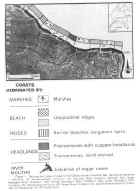|
Naturaliste can. (Rev. Ecol. Syst.),
109(1982): 415-429
GEOMORPHOLOGICAL FEATURES OF THE ONTARIO
COAST OF HUDSON BAY
I.P. MARTINI
Department of Land Resource Science
University of Guelph, Guelph, Ontario N1G 2W1
¡¡
 The Ontario coast of Hudson Bay is 580 km
long, and generally flat (0.5-0.7 m/km). Its variable features reflect the
strength and structural setting of the substratum, the amount of material
available to the nearshore environments, and the predominant marine processes.
The overall structure of the Paleozoic bedrock differentiates the Ontario coast
into two segments. The NW-SE trending section west of Winisk is varied and
characterized by numerous outcrops of different rock formations. The east-west
trending tract east of Winisk is more uniform and underlain primarily by a
single carbonate rock unit deposited on the flank of the Cape Henrietta Maria
Arch. Those shores can be further subdivided according to dominance of marshes,
beach ridges, promontories, or river mouths--some showing beach ridges enclosing
lagoons. The coasts dominated by marshes and those with lagoons behind the
coastal ridges change rapidly as the land emerges isostatically. A comparison
between air photographs taken in 1954 and 1976 indicates that some marshes have
prograded up to 400 m, with approximately 3.3 km2 of new marsh formed
over a 6.0 km long reach. Similarly, new ridges have developed from embryonic
forms, migrating slightly landward and progressively straightening on the
seaward side. Some coasts dominated by lagoons show no progradation or a slight
average retreat of the shoreline (approximately 300 m), but their lagoons become
increasingly protected and restricted, and parts of them emerge to form new
marshes. The Ontario coast of Hudson Bay is 580 km
long, and generally flat (0.5-0.7 m/km). Its variable features reflect the
strength and structural setting of the substratum, the amount of material
available to the nearshore environments, and the predominant marine processes.
The overall structure of the Paleozoic bedrock differentiates the Ontario coast
into two segments. The NW-SE trending section west of Winisk is varied and
characterized by numerous outcrops of different rock formations. The east-west
trending tract east of Winisk is more uniform and underlain primarily by a
single carbonate rock unit deposited on the flank of the Cape Henrietta Maria
Arch. Those shores can be further subdivided according to dominance of marshes,
beach ridges, promontories, or river mouths--some showing beach ridges enclosing
lagoons. The coasts dominated by marshes and those with lagoons behind the
coastal ridges change rapidly as the land emerges isostatically. A comparison
between air photographs taken in 1954 and 1976 indicates that some marshes have
prograded up to 400 m, with approximately 3.3 km2 of new marsh formed
over a 6.0 km long reach. Similarly, new ridges have developed from embryonic
forms, migrating slightly landward and progressively straightening on the
seaward side. Some coasts dominated by lagoons show no progradation or a slight
average retreat of the shoreline (approximately 300 m), but their lagoons become
increasingly protected and restricted, and parts of them emerge to form new
marshes.
|